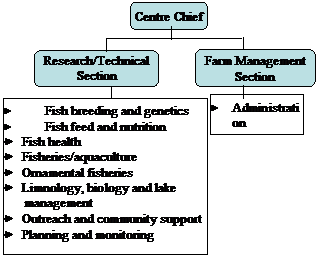Historical Background
Established in 1962 as “Lake Development Centre” which was changed the name as Fisheries Development Centre in late 1960s
In 1975 an “Integrated Fishery and Fish Culture Development Project (NEP/73/25)” was implemented under FAO/UNDP cooperation
Later recognized as “Fisheries Research Centre” with the name of “Agriculture Research Station (Fisheries), Pokhara in 1993 under Nepal Agricultural Research Council (NARC)
Functioning as “Lake Fisheries Research Station” for aquatic and fisheries resources conservation and utilization
Facilitated in expansion of cage fish culture and open water fisheries management in Nepal
Technical/resource support and services to pond/cage aquaculture farmers and fishers
Goal
Enhancement of fisheries/aquaculture contribution to livelihoods, especially those of the wetland dependant rural poor
Objectives
- Development of appropriate aquaculture technologies for improving production and productivity
- Development of appropriate inland water management and resource conservation technologies for supporting wetland dependent community
- Appropriate delivery of technical and resource services to the farmers/fishers community in western Nepal
Themetic Area of the Program
- Fisheries and aquaculture technology generation for poverty reduction and increased water productivity according to NARC policy guidelines
- Domestication of native fish species for use in aquaculture and genetic resource conservation
- Development/improvement of aquaculture technologies suitable for various natural water
- Research on fish stock improvement, nutrition and health of aquaculture species
- Research on modality of co-management of wetlands for sustainable conservation and utilization
Working Areas and Activities
- Selective breeding to improve the stock performance of aquaculture species
- Development of small-scale and low level-input based fish farming for ultra-poor community
- Productivity assessment of pond/cage/enclosure/ raceway/rice field/cold water fish to identify appropriate technology recommendation domain
- Implementation of research, more specifically in fish nutrition, physiology, genetics and pathology for developing intensive warm freshwater fish farming systems for commercially important native and exotic fish
- Environmental, social and economical impact of aquaculture technologies and fish farming system
- Water environment/water chemistry survey to optimize the utilization of natural productivity of water resources into fish production
- Participatory fish stock enhancement for vulnerable native fish species in target water body
- Demonstration of fisheries co-management in lakes and stream
- On farm testing and verification of generated technology and scientific information in farmer’s field
- Technical support to coldwater aquaculture
Milestones
- Preparation of aquatic environment
- database of the Lakes of Pokhara valley,
- Development and scaling up of cage fish culture technology in lakes and reservoirs,
- Improvement and scaling up of low cost, small-scale rural aquaculture technology,
- Domestication and development of production technology of indigenous fish species (Tor putitora, Labeo dero, ect),
- Feed formulation of carp for different development stages,
- Standardization of carp seed production technology in mid hill region of Nepal,
- Strengthening co-management model for lake fishery conservation and utilization
Physico-chemical characteristics of the lakes
| Parameters | Phewa | Begnas | Rupa |
| Elevation, msl | 742 | 650 | 600 |
| Area, ha | 523 | 328 | 135 |
| Catchment, km2 | 110 | 20 | 30 |
| Max. Depth, m | 24 | 10 | 6 |
| Temperature, oc | 16-30 | 16.31 | 14-28 |
| Dissolve Oxygen, mg/L | 5.7 | 4.6 | 7.6 |
| pH | 6.6 | 6. | 6.8 |
| Sechi disc visibility, m | 2.6 | 2.2 | 1.0 |
| Chlorophyll a, µg/L | 11.4 | 7.4 | 11.5 |
| Ammonium-N, mg/l | 0.001 | 0.005 | 0.001 |
| Nitrite+Nitrate -N, mg/l | 0.002 | 0.004 | 0.002 |
| Phosphate (PO4), mg/l | 0.001 | 0.001 | 0.002 |
| Total phosphorus , mg/l | 0.004 | 0.003 | 0.006 |
Sourse: FRC, Pokhara, 2007
Centre’s Structure and Units
Centre has been implementing the activities by forming following sections and units for accomplishment of the objectives. Major units under the FRC Pokhara are as follows:

Physical Facilities
Farm area at Begnas 8.5 ha, Phewa 1.3 ha and Rupa 0.1 ha. Main facilities of the Centre are brood ponds, nursery ponds, experimental/raceway ponds, warm water and indigenous hatchery, feed house, training hall, office cum laboratory, fish collection sheds, pump house, guard house, residence houses, generator etc.
Staff
Presently altogether 44 staff categorized as scientific, technical and support staffs are working at the Centre.
Collaborators and Partners
- Institute of Agriculture and Animal Science (IAAS), Rampur
- Directorate of Fisheries Development, (DoFD),
- Department of Agriculture
- District Agriculture Development Offices
- Fisheries Development Centres (FDCs)
- Fisheries Research Centres (FRCs)
- Fish Entrepreneurs Association, Phewa and Begnas lakes
- Fisher’s women groups, Phewa and Begnas
- Rupa Lake Restoration and Fishisheries Cooperative
- National Agriculture Research and Development Fund (NARDF)
- Others: UNDP, FAO, JICA, ADB, NACA, IDRC, NTNU
Researchers
- Dr. Md. Akbal Husen, Senior Scientist (S-3)
Contact Address
Nepal Agricultural Research Council
Fishery Research Station
Post Box: 274, Pokhara, Kaski
Tel: 061-560089, 560825 (Begnas) 061-462004 (Phewa)
E-mail: frcpokhara@gmail.com
Website: www.frspokhara.gov.np
